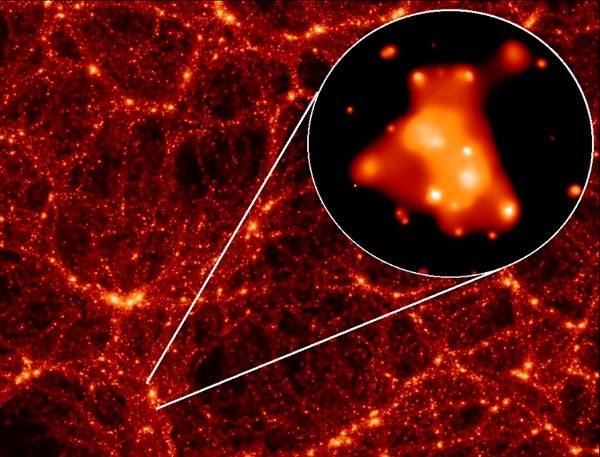A group of astronomers recently discovered that old galaxy clusters have similar “scaling relations” to nearby clusters. Ben Maughan of the Harvard-Smithsonian Center for Astrophysics will present the results April 8 at the Royal Astronomical Society’s National Astronomy Meeting in Birmingham, England. The study used NASA’s Chandra X-ray observatory and ESA’s XMM-Newton telescope to observe X rays from 11 clusters at redshifts of 0.6 to 1.0, or 6 to 8 billion light-years away.
Galaxy clusters are the knots in cosmic filaments. Knowing their distribution, mass, and other properties is crucial to understanding cosmic evolution. This finding helps estimate clusters’ masses and will therefore improve structure formation models. According to Maughan, “weighing distant galaxy clusters could become as easy as converting from Fahrenheit to Celsius.”
Measuring a cluster’s mass is difficult, so astronomers use simplified relations to estimate the mass from observable qualities. They can measure a cluster’s luminosity and temperature directly, and from these values, calculate the mass. Maughan’s group found the 11 clusters have masses ranging from 200 to 1,100 times the mass of our galaxy.
They then used the clusters’ distances and masses to find that the clusters are scaled almost proportionally to each other. They discovered distant clusters and those nearby are similar, with the only difference accounted for by the universe’s expansion. Scientists refer to this as “weakly self-similar.”
Astronomers can now use the same scaling relations to weigh galaxy clusters whether the clusters are nearby or 8 billion light-years distant – and possibly farther, although more research is needed.
Other team members include Laurence Jones of the University of Birmingham, England; Harald Ebeling of the Institute for Astronomy of the University of Hawaii; and Caleb Scharf of Columbia University in New York City.










